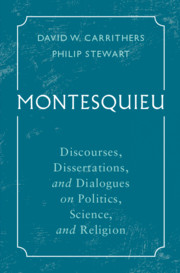Book contents
- Montesquieu
- Additional material
- Montesquieu
- Copyright page
- Contents
- Abbreviations
- A General Note on the Texts
- Introduction
- i The Uses of Science
- ii The Romans
- iii Reflections on National Character
- iv Politics and Morality
- v Statecraft
- vi Economics and Fiscal Policy
- vii Defense of The Spirit of Law (1750)
- Montesquieu Chronology
- Bibliographical Note
- Index
vi - Economics and Fiscal Policy
Published online by Cambridge University Press: 02 November 2020
- Montesquieu
- Additional material
- Montesquieu
- Copyright page
- Contents
- Abbreviations
- A General Note on the Texts
- Introduction
- i The Uses of Science
- ii The Romans
- iii Reflections on National Character
- iv Politics and Morality
- v Statecraft
- vi Economics and Fiscal Policy
- vii Defense of The Spirit of Law (1750)
- Montesquieu Chronology
- Bibliographical Note
- Index
Summary
In Memorandum on the Debts of State (1715) Montesquieu explains how to curb France’s debt crisis stemming principally from Louis XIV’s war-mongering. Rather than recommending declaration of bankruptcy, he proposes a gradual reduction of the debt by means of a partial repudiation. The greater the proportion of an individual’s overall wealth invested in the crown’s debt, the less the reduction would be, since such individuals would have fewer other investments. Montesquieu was confident his debt reduction plan would succeed and predicted the king would be able to reduce taxes. In his Considerations on the Wealth of Spain (1727–1728) he explains that the main reason for the collapse of Spain as a powerhouse in modern Europe was that the Spanish became the victims of inflation. The more bullion brought to Spain’s shores, the less valuable it became since more and more specie chased roughly the same amount of goods.
- Type
- Chapter
- Information
- MontesquieuDiscourses, Dissertations, and Dialogues on Politics, Science, and Religion, pp. 206 - 223Publisher: Cambridge University PressPrint publication year: 2020



